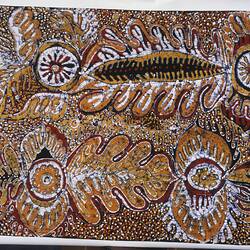Summary
Pitjantjatjara artist, Imuna Kenta is one of the many skilled female artists who learnt a variety of arts and crafts whilst living at Ernabella mission in South Australia. Imuna moved to the mission with her family whenshe was a young child and afer attending the school she worked in the craftroom. Batik was first taught at Ernabella Arts in 1971 by two international specialists invited to the community to teach the women. Batik textiles made at Ernabella by Imuna and the other artists have featured in many national and international exhibitions and collections and like many of her contemporaries from the mission. Imuna continues to work in new media including with the Tjanpi Desert Weavers. In addition to her art, Imuna is a respected senior member of her community participating in the National Indigenous Languages Support program teaching language and culture to younger members of her community.
Physical Description
Cotton Batik. Designs in yellow, red and white with a black/blue background.
Significance
Batik became a signature art form for Ernabella artists following the introduction of the craft in the early1970s. Pitjantjatjara women subsequently demonstrated their techniques to other Aboriginal communities. This is part of a long history of craft production at Ernabella, established in 1937, when the Presbyterian Church took over the lease of a sheep station situated in the Anangu Pitjantjatjara Yankunytjatjara (AYP) Lands. In 1948 a craft room was set up to provide employment for the women on the mission and Ernabella Arts continues to operate as an outlet for the production and sales of an increasingly diverse range of arts making it one of Australia's longest continuously running Aboriginal arts centres.
More Information
-
Object/Medium
Textile
-
Maker
-
Cultural Groups
-
Locality
-
Date Produced
-
Collector
-
Date Collected
-
Object Measurements
850 mm (Length), 115 mm (Width), 110 mm (Height)
-
Keywords
-
References
[Book] 1992. Women's work: Aboriginal women's artefacts in the Museum of Victoria.
-
Type of item
-
Discipline
-
Category
-
Collecting Areas



